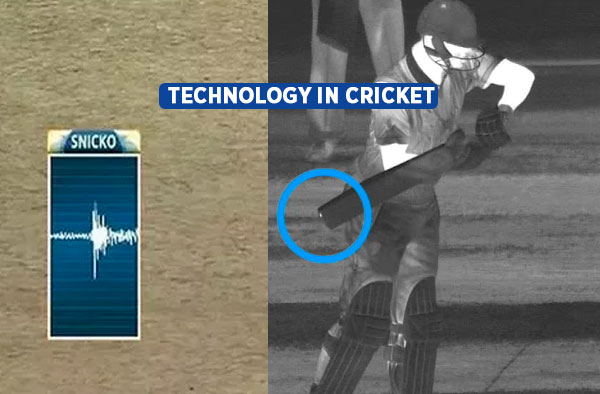Cricket, a sport deeply rooted in tradition and fair play, has seen its fair share of controversies over the years. From disputed catches to questionable LBW decisions, the need for accurate and unbiased technology in the game has become more apparent than ever. Enter Snicko and Hot Spot, two revolutionary technologies that have taken the cricketing world by storm.

Snicko, a sound-based technology, and Hot Spot, an infrared imaging system, work in tandem to provide a level of accuracy and fairness like never before. By capturing the tiniest of edges and detecting even the faintest of touches, these innovations have transformed the way decisions are made on the field. Gone are the days of contentious appeals and endless debates. With Snicko and Hot Spot, cricket has taken a huge leap forward in ensuring fairness and transparency, ultimately enhancing the integrity of the game. In this article, we will delve deeper into how these technologies work, and their impact on the game.
Cricket and technology
No longer do players and officials face heated arguments over contentious decisions; technology now provides conclusive evidence in cricket matches. Thanks to Hawk-Eye technology and Snickometer’s implementation, it has become easier than ever before to analyze crucial moments during matches, guaranteeing fair play while minimizing human error.
Today’s cricket betting ecosystem relies heavily on technology, facilitating smooth transactions, secure payments, and efficient bookkeeping. Features like automated odds calculation and real-time updates make technology essential in creating an unbiased betting ecosystem for bookmakers and bettors alike. If you are still looking for a reliable sportsbook, you can check the Lottoland cricket betting platform.
How Snicko works in cricket?
Snicko, a sound-based technology, has transformed the way decisions are made on the field. It works by using highly sensitive microphones placed around the ground to capture the faintest of sounds. When the ball brushes against the bat or any other equipment, Snicko picks up the slight change in sound frequency and converts it into a visual representation. This visual representation is then displayed in real-time to the third umpire, who can analyze it from multiple angles to determine if there was any contact between the bat and ball.
One of the key advantages of Snicko is its ability to detect even the tiniest of edges. In the past, close calls were often left to the discretion of the on-field umpires, leading to heated debates and questioning of their decision-making. With Snicko, the decision-making process becomes more objective, eliminating the possibility of human error or bias. This technology has been widely embraced by players, officials, and fans alike, as it brings a new level of fairness and accuracy to the game.
Benefits of using Snicko technology
The use of Snicko technology in cricket brings several benefits to the game. Firstly, it ensures that decisions are made based on concrete evidence rather than mere speculation. This not only enhances the accuracy of decision-making but also adds a layer of transparency to the game. Players can have confidence in the fact that their fate is not solely determined by the subjective judgment of the on-field umpires.
Secondly, Snicko technology has the potential to resolve contentious appeals quickly. In the past, players would often challenge the umpire’s decision, leading to delays in the game and disrupting its flow. With Snicko, the decision-making process becomes more streamlined, as the third umpire can review the evidence in a matter of seconds. This reduces the time wasted on unnecessary debates and allows the game to proceed smoothly.
Furthermore, Snicko technology has the potential to minimize the impact of umpiring errors on the outcome of the game. In a sport where a single decision can change the course of a match, it is crucial to have a reliable tool that provides accurate information. Snicko’s ability to capture even the slightest of edges ensures that no legitimate wicket goes unnoticed and no incorrect decisions are made, thereby preserving the integrity of the game.
How does Hot Spot work in cricket?
In addition to Snicko, another technology that has revolutionized decision-making in cricket is Hot Spot. Hot Spot is an infrared imaging system that detects friction and heat caused by contact between the ball and the bat or the ball and the player’s body. This technology works by using a set of highly sensitive cameras that capture the thermal energy generated during such instances.
When the ball makes contact with the bat or the player, the heat generated is instantly picked up by the cameras. This information is then processed and presented as a visual representation, revealing any areas of increased temperature. The third umpire can analyze these Images to determine if there was any contact, even if it was too faint to be seen with the naked eye.
Advantages of Hot Spot Technology
Hot Spot technology offers several advantages in the game of cricket. Firstly, it provides an additional layer of evidence to support decision-making. In cases where the ball brushes against the bat or the player’s body without any visible signs, Hot Spot can reveal the contact through the detection of heat. This helps eliminate any doubts or speculations, ensuring that the correct decision is reached.
Secondly, Hot Spot technology has the potential to resolve disputes related to catches. In the past, catches that were too close to call often led to disagreements between the fielding team and the batsman. Hot Spot provides a definitive answer by highlighting the areas of contact between the ball and the bat or the player’s body. This reduces the chances of erroneous decisions and promotes fair play.
Furthermore, Hot Spot technology has the ability to capture even the faintest of touches. In situations where the ball barely grazes the bat or the player’s body, it can be challenging for the naked eye to detect any contact. Hot Spot’s thermal imaging capabilities overcome this limitation, ensuring that no legitimate wicket or run goes unnoticed.
Controversies and criticisms surrounding Snicko and Hot Spot
Despite their numerous benefits, Snicko and Hot Spot have not been without their fair share of controversies and criticisms. One of the main concerns raised is the reliability of these technologies. While they have been proven to be highly accurate in most cases, there have been instances where controversial decisions were made based on the evidence provided by Snicko or Hot Spot.
Critics argue that these technologies are not infallible and can sometimes produce misleading results. Factors such as ambient noise, bat vibrations, or even the position of the microphones or cameras can affect the accuracy of the readings. Additionally, the interpretation of the visual representations by the third umpire can also be subjective, leading to potential errors in decision-making.
Conclusion
Snicko and Hot Spot technologies have brought significant advancements to decision-making in cricket. They improve the accuracy and objectivity of on-field decisions while eliminating human bias and human error. They offer concrete evidence-based decisions that quickly resolved appeals and reduced the impact of umpiring errors but have drawn criticism for potentially misleading results and raised controversies regarding reliability with which results may differ from than intended. Though these technologies have made great strides toward improving decision-making they still need continuous refinement to remain effective while upholding the game’s integrity.

Loves all things female cricket